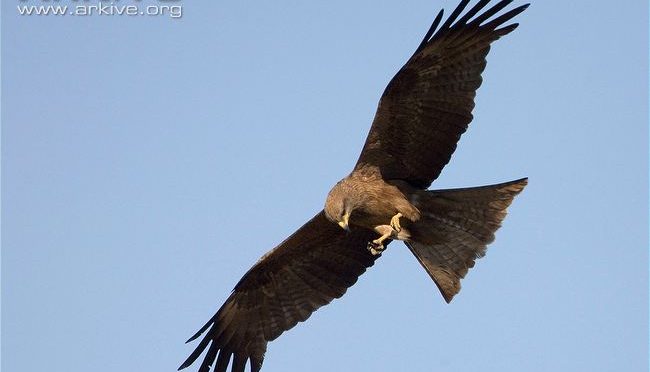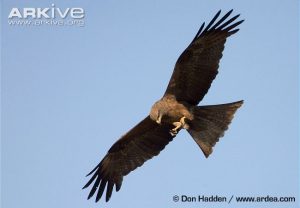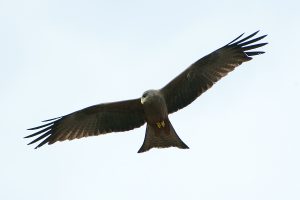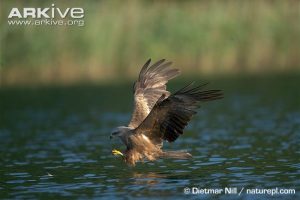| Common Name | (in English) Black Kite |
| (in Chinese) 黑鳶、麻鷹、老鷹 | |
| Scientific Name | (in Latin) Milvus migrans |
| Peculiar characteristics / external features: | The black kites have a brown upper plumage is brown but the head and neck tend to be paler. The sexes are alike. The patch behind the eye appears darker. The outer flight feathers are black and the feathers have dark cross bars and are mottled at the base. The lower parts of the body are pale brown, becoming lighter towards the chin. The body feathers have dark shafts giving it a streaked appearance. The cere and gape are yellow, but the bill is black (unlike in the yellow-billed kite). The legs are yellow and the claws are black. They have a distinctive shrill whistle followed by a rapid whinnying call. Males and females have the same plumage but females are longer than males. Their wingspan is around 150 cm. |
| Distributions: | The species is found in Europe, Asia, Africa and Australia. The temperate populations of this kite tend to be migratory while the tropical ones are resident. In some areas such as in the United Kingdom, the black kite occurs only as a wanderer on migration. These birds are usually of the nominate race. |
| Habits: | |
| Dietary | They are opportunist hunters and have been known to take birds, bats, and rodents. They are attracted to smoke and fires, where they seek escaping prey. |
| Reproductive (Solitary/Social/Territorial, Courtship Behavior, Taking care of youngs, etc) | The breeding season of black kites in India begins in winter (mainly January and February[28]), the young birds fledging before the monsoons, while the European birds breed in summer. Birds in the Italian Alps tended to build their nest close to water in steep cliffs or tall trees. Nest orientation may be related to wind and rainfall. After pairing, the male frequently copulates with the female. Unguarded females may be approached by other males, and extra pair copulations are frequent. Males returning from a foraging trip will frequently copulate on return, as this increases the chances of his sperm fertilizing the eggs rather than a different male. Both the male and female take part in nest building, incubation and care of chicks. |
| Whatever appropriate | |
| Interesting Fact: | Despite their name, they aren’t actually black, although they can look black from a distance. They are really dark brown with some lighter markings.
Unlike most other raptors, black kites can form large flocks, especially during plagues of grasshoppers, when hunting near fires or when migrating large distances. |
Photos (at least 3):
References:
Voice of Black Kite:
https://identify.whatbird.com/obj/1249/_/Black_Kite.aspx
Video:




